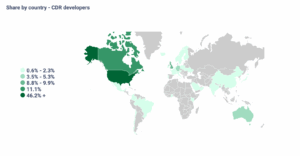
Voluntary Carbon Market Insights & FAQs
Everything you’ve ever wanted to know about the voluntary carbon market – and more!
Direct Air Capture (DAC)
What Is Direct Air Capture (DAC) and How Does It Work?
- Direct Air Capture (DAC) is an engineered carbon dioxide removal (CDR) technology that uses chemical reactions to extract CO2 directly from the atmosphere.
- When air passes over chemical agents (sorbents or solvents), they selectively react with and trap CO2, allowing other components of air to pass through. The captured CO2 is then:
- Stored underground in geological formations
- Mineralized into stable carbonates
- Utilized in industrial processes
- What are the different types of DAC?
- Solid-DAC (SDAC) – Uses solid sorbents to capture CO2.
- Liquid-DAC (LDAC) – Uses liquid solvents to absorb CO2.
- DAC is projected to remove up to 5 GtCO2per annum by 2050 according to the IPCC.
Why Is Direct Air Capture (DAC) Important? And What is its Role in Achieving Net Zero Emissions?
- Direct Air Capture is important as the IPCC estimates that 5-40 gigatons of CO2 must be removed annually by mid-century to remain below 1.5°C warming. DAC combined with permanent storage could remove up to 310 gigatons by 2,100, making rapid scale-up essential.
- DAC delivers permanent carbon removal and helps:
- Address historical emissions
- Complement other climate solutions
- Enable net negative emissions in the long term
What is Happening in the Direct Air Capture (DAC) Market now?
- To date over 2.7 million credits have been sold, with the most of it coming from 3 project developers namely 1point five, climeworks and carbon capture inc. DAC credits are some of the most expensive credits in the market right now with prices ranging between $300 – $1,000. Overall approximately 3 billion dollars have been invested in DAC.
Total investment by round

What Is the Current Project Activity and Capacity Development in Direct Air Capture (DAC) Worldwide?
- There are currently 171 project developers working on Direct Air Capture (DAC) globally. The highest concentration of projects is in the United States, Canada, and the United Kingdom.
- In terms of the volume of carbon credits sold, the United States leads the market, followed by Canada and Switzerland. AlliedOffsets’ data indicates both a strong project pipeline in these countries and active commercial engagement with buyers securing future DAC capacity.

How Does AlliedOffsets Track Direct Air Capture (DAC) Credit Activity in the Voluntary Carbon Market?
With data from 35+ registries, we provide the most comprehensive credit tracking in the voluntary carbon market (VCM). Our dataset covers:
- DAC issuances
- Retirements
- Offtake agreements
- Purchase vs. delivery trends over time
Quarterly Prices

What Are the Current Buyer Trends in the Direct Air Capture (DAC) Market?
- The Direct Air Capture (DAC) market is currently led by major corporate buyers, with Microsoft securing the largest share of credits through multiple deals. Other notable purchasers include Airbus, Amazon, Frontier (with commitments across several projects), and BCG.
- While these large companies dominate contracted volumes, the DAC buyer base is gradually expanding. New participants from various industries are entering the market, drawn by DAC’s high durability and its potential to play a critical role in long-term Net Zero strategies.
CDR purchases by sector

What Are the Main Challenges in Scaling Direct Air Capture (DAC) for Climate Solutions?
The main challenges in scaling DAC for climate solutions are:
- High energy demands – Regeneration of sorbents/solvents requires substantial low-carbon energy.
- High costs – Current estimates range from $400–$1,000/tCO2.
- Resource intensity – Requires significant land, water, and energy inputs.
- Policy gaps – Limited incentives and regulatory clarity.
What Are the Key Benefits of Direct Air Capture (DAC) Technology?
The key benefits of DAC technology are:
- Permanent carbon removal – Geological storage ensures CO2 is sequestered for centuries to millennia.
- Scalable & flexible – Deployable in diverse locations, independent of emission sources.
- Industrial integration – Can utilize waste heat from industry to lower energy requirements.
- Modular deployment – Can be scaled incrementally to gigaton levels.